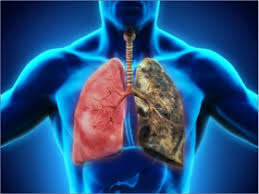Chronic airway obstruction denotes an alteration in the mechanical properties of the lungs characterized by poorly reversible increased hindrance to expiatory airflow; it is usually but not necessarily accompanied by increased resistance to inspiration. It occurs mainly in association with primary disorders of the lungs such as chronic bronchitis, emphysema, and asthma, but rarely may complicate systemic disorders such as polyarteritis nodosa.
The two main abnormalities responsible for this obstruction are, first, generalized narrowing of the bronchi and, second, destruction of the pulmonary parenchyma. An understanding of the interaction of these two factors is important in order to appreciate the significance of the abnormalities involved and the nature of the disability experienced by the patient.
MECHANISMS OF AIRWAY OBSTRUCTION.
During inspiration, the inspiratory muscles lower alveolar pressure, and air flows into the alveoli at a rate which depends upon the caliber of the bronchi. During expiration, recoil of stretched elastic tissues expels air from the lungs by raising intraalveolar pressure above mouth pressure. The rate of flow depends upon the pres- sure difference and the resistance of the airways. In normal subjects, this mechanism is sufficient to meet ventilatory needs even under conditions of severe exercise.
In subjects with increased resistance to airflow, elastic recoil alone may not be sufficient to achieve the ventilation required, and active expiratory muscular efforts may be made. However, the increased intrathoracic pressure which results from this expiration muscle effort introduces a new factor in expiratory airflow, a tendency to compression of the large airways. The key to understanding this new factor is that elastic recoil of the lung alone is responsible for raising intrabronchial pressure above in, trathoracic pressure. Providing that the pressure within the bronchi is higher than intrathoracic pressure, there is no airway compression.
However, when expiratory airflow is increased in subjects with raised airway resis- tance or diminished elastic recoil of the lungs, the greater pressure drop along the bronchial tree may cause the pressure inside the trachea and large bronchi to fall below the surrounding intrathoracic pressure, and these structures will be compressed unless there is sufficient rigidity in their walls to resist it.
Once compression occurs, no amount Of further effort will increase airflow because the pressure within the bronchi cannot be increased without simultaneously increasing the sur- rounding pressure. In this way, compression which usually occurs in the larger segmental or main-stem bronchi forms a flow-limiting mechanism (often called a Starling resistor), and determines maximal rate of expiratory airflow. This mechanism cannot operate during inspiration; the rate of inspiratory airflow is always effort dependent.
Increased Airway Resistance.
Increased airway resistance may be due to increased secretions; thickening of the wall of the airways caused by infiltration, edema, or glandular hypertrophy; or constriction resulting from smooth muscle contraction or fibrosis; deformity of the bronchi may also contribute. The dominant mechanism varies in different circumstances. When associated with chronic bronchitis, there are both narrowing of the smaller bronchi and increased mucus, sometimes causing plugging. When emphysema is also present, there are both narrowing and a slight loss in the number of airways, with an increased tendency to mucus plugging.
The role of infection is doubtful; it has not been possible to establish a correlation between the rate of progression of airway obstruction and the frequency of infective bronchial episodes, although during acute infections ainvay obstruction is temporarily increased. In some areas, complete occlusion of bronchi requires that ventilation of distal areas be by collateral channels. thereby increasing airway resistance. It is possible that narrow- ing of chronic airways may involve increased smooth muscular tone at least in the initial stages before irreversible structural changes develop.
wo observations suggest that some process additional to the results of chronic inflammation and fibrosis may be involved. First, hyper-reactivity of the bronchi is a feature of most patients with narrowing of the small airways; second, airway resistance is reduced, albeit to a small degree, after administration of Isoproterenol and atropine aero- sols.
Decreased Rigidity of the Walls of Larger Airways.
A diminished rigidity of the trachea and bronchi is a common feature of chronic mucopurulent bronchitis. In it- self, it is not responsible for reducing maximal expiratory airflow but predisposes toward airway compression when the other factors are present.

